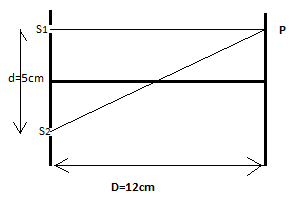
If the first minima in Young’s double-slit experiment occur directly in front of the slits (distance between slit and screen \[D = 12cm\] and distance between slits \[d = 5cm\], then the wavelength of the radiation used can be
A. \[2cm\]
B. \[4cm\]
C. \[\dfrac{2}{3}cm\]
D. \[\dfrac{4}{3}cm\]
Answer
575.1k+ views
Hint: Superposition principle says when two or more waves overlap in space, the resultant disturbance is the sum of the individual disturbances.
In this question, it is given that a first minimum obtained on the screen is directly in front of the slits; hence we have to find the wavelength of the radiation given as \[\vartriangle x = \left( {2n - 1} \right)\dfrac{\lambda }{2}\]. First we need to evaluate the distance travelled by the radiated light in between the two slits one by one and then, equating their difference with the formula \[\vartriangle x = \left( {2n - 1} \right)\dfrac{\lambda }{2}\] to get the result.
Complete step by step solution:
Distance between screen and slit \[D = 12cm\]
Distance between slits \[d = 5cm\]
First minima fall directly in front of the slit \[{S_1}\] at point P

Distance travelled by wave from \[{S_1}\]to \[{S_1}P\]\[ = 12cm\]
The path travelled by light from slit \[{S_2}\]to \[{S_2}P\]\[ = \sqrt {{D^2} + {d^2}} = \sqrt {{{12}^2} + {5^2}} = \sqrt {144 + 25} = \sqrt {169} = 13cm\]
So the path difference between two minima \[\vartriangle x = {S_2}P - {S_1}P = 13 - 12 = 1cm\]
Given the point for first minima\[\left( {n = 1} \right)\], \[\vartriangle x = \left( {2n - 1} \right)\dfrac{\lambda }{2} = \left( {2 \times x - 1} \right)\dfrac{\lambda }{2} = \dfrac{\lambda }{2}\]
Hence we can write:
\[
\vartriangle x = \dfrac{\lambda }{2} \\
\dfrac{\lambda }{2} = 1 \\
\lambda = 2cm \\
\]
Hence the wavelength of the radiation is 2cm Option A.
Note: A point on the screen where the wave crest of one wave falls on the wave crest of other, the resultant amplitude is maxima. A point on the screen where the wave crest of one falls on the wave trough of another, the resulting amplitude is minima.
In this question, it is given that a first minimum obtained on the screen is directly in front of the slits; hence we have to find the wavelength of the radiation given as \[\vartriangle x = \left( {2n - 1} \right)\dfrac{\lambda }{2}\]. First we need to evaluate the distance travelled by the radiated light in between the two slits one by one and then, equating their difference with the formula \[\vartriangle x = \left( {2n - 1} \right)\dfrac{\lambda }{2}\] to get the result.
Complete step by step solution:
Distance between screen and slit \[D = 12cm\]
Distance between slits \[d = 5cm\]
First minima fall directly in front of the slit \[{S_1}\] at point P

Distance travelled by wave from \[{S_1}\]to \[{S_1}P\]\[ = 12cm\]
The path travelled by light from slit \[{S_2}\]to \[{S_2}P\]\[ = \sqrt {{D^2} + {d^2}} = \sqrt {{{12}^2} + {5^2}} = \sqrt {144 + 25} = \sqrt {169} = 13cm\]
So the path difference between two minima \[\vartriangle x = {S_2}P - {S_1}P = 13 - 12 = 1cm\]
Given the point for first minima\[\left( {n = 1} \right)\], \[\vartriangle x = \left( {2n - 1} \right)\dfrac{\lambda }{2} = \left( {2 \times x - 1} \right)\dfrac{\lambda }{2} = \dfrac{\lambda }{2}\]
Hence we can write:
\[
\vartriangle x = \dfrac{\lambda }{2} \\
\dfrac{\lambda }{2} = 1 \\
\lambda = 2cm \\
\]
Hence the wavelength of the radiation is 2cm Option A.
Note: A point on the screen where the wave crest of one wave falls on the wave crest of other, the resultant amplitude is maxima. A point on the screen where the wave crest of one falls on the wave trough of another, the resulting amplitude is minima.
Recently Updated Pages
A man running at a speed 5 ms is viewed in the side class 12 physics CBSE

The number of solutions in x in 02pi for which sqrt class 12 maths CBSE

State and explain Hardy Weinbergs Principle class 12 biology CBSE

Write any two methods of preparation of phenol Give class 12 chemistry CBSE

Which of the following statements is wrong a Amnion class 12 biology CBSE

Differentiate between action potential and resting class 12 biology CBSE

Trending doubts
What are the major means of transport Explain each class 12 social science CBSE

Which are the Top 10 Largest Countries of the World?

Draw a labelled sketch of the human eye class 12 physics CBSE

How much time does it take to bleed after eating p class 12 biology CBSE

Explain sex determination in humans with line diag class 12 biology CBSE

When was the first election held in India a 194748 class 12 sst CBSE




